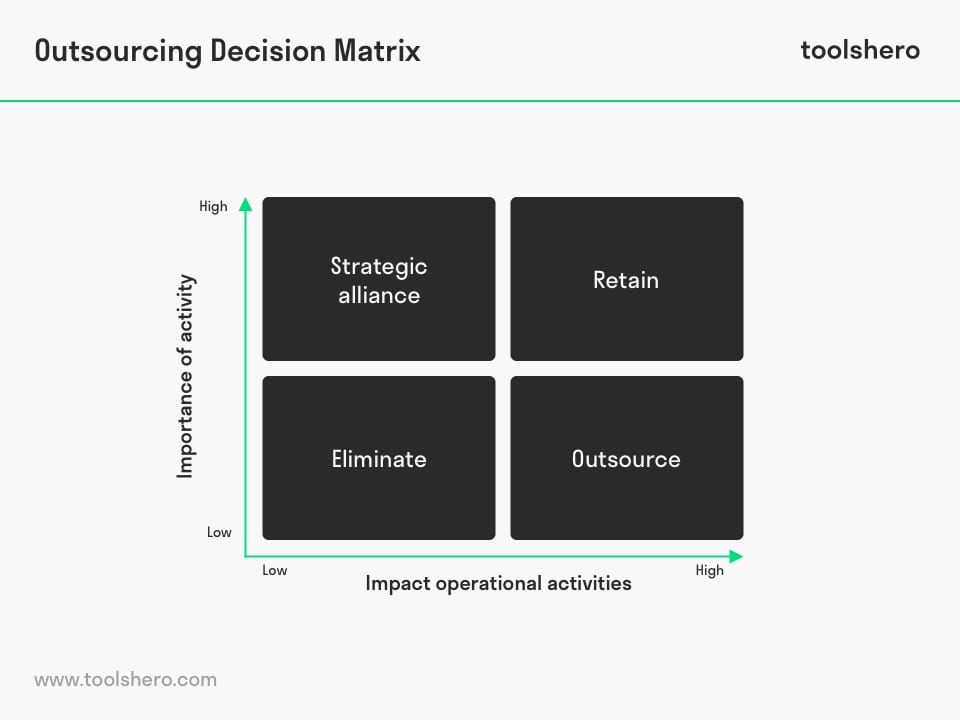Outsourcing Decision Matrix

Outsourcing Decision Matrix: this article provides a practical explanation of the Outsourcing Decision Matrix. Next to what it (theory and origin) is, this article also highlights the four quadrants of the Outsourcing Decision Matrix and how to use it. After reading, you’ll have a basic understanding of this strategic management tool. Enjoy reading!
What is an Outsourcing Decision Matrix? The basic theory and origin
It is often a difficult choice for organisations to decide whether to outsource an activity or service or do it themselves. Outsourcing tasks to another company can have both a positive and a negative impact on the company’s results.
On the one hand, it can lead to reduced overhead, add new expertise, and save a lot of time. On the other hand, there is little or no control over the execution of these outsourced tasks, and if things do go wrong, there is a good chance that they will have negative consequences.
In particular, quality standards and the service provided by an organisation cannot always be guaranteed by the company to which the tasks have been outsourced. Correcting the errors usually costs time and money.
Origin of the Outsourcing Decision Matrix
The Outsourcing Decision Matrix can then offer a solution and gives organisations a good overview of the choices to be made. Dornier originally came up with the Outsourcing Decision Matrix (OMD) in 1998. It is a handy management tool that is still useful for many companies today. Its strength lies in its simplicity and it can help form a strategic alliance with suplliers or other type of partners.
In a clear matrix, four quadrants are created which provide companies with good insight into whether to consider outsourcing, or not.
The Outsourcing Decision Matrix: four quadrants
By using an outsourcing decision matrix, an organisation can determine at a glance whether to keep certain processes in-house, or to outsource them. The model addresses two main factors that organisations should consider whenever they want to outsource tasks:
1. Strategic Impact
What is the strategic importance of the activity? Will the task or activity give the company a competitive advantage? In general, internal tasks are of strategic importance. Some tasks cannot be carried out within the organisation, but they are nevertheless of strategic importance. In that case, outsourcing may be considered.
2. Operational Impact
What impact does the activity or task have on operational performance? To what extent does the task ensure that the organisation function smoothly? How time consuming is the task? What are the consequences if tasks are not carried out correctly?
Both factors are placed on two axes in the model; the Strategic Impact is located on the y-axis, and the Operational Impact is located on the x-axis. These axes shift from low to high influence, and this results in four quadrants, from which an organisation can draw a logical consequence. By placing tasks in this quadrant

Figure 1 – the Outsourcing Decision Matrix model
Strategic alliance within the Outsourcing Decision Matrix
In this case, these are tasks that have a high strategic impact on the organisation, but contribute little to its operational performance. Such tasks cannot be carried out internally, but they are important for the survival of the organisation.
In this case, think of the entire IT environment of a large airport such as Schiphol. The airport employs many highly-educated IT staff, but to set up and maintain the security system, the airport needs the expertise of an external IT security company.
Without a security system, the airport will not be able to function properly and as such, it is wise to opt for a strategic alliance, which allows remote control. It concerns a permanent, trusted cooperation partner with whom a long-term cooperation commences.
Outsourcing
Within the Outsourcing Decision Matrix, this concerns both a low strategic impact and a high operational impact because the activities are important for successful operational performance. Such activities or tasks can be outsourced at low risk.
One example is an assembly company that uses semi-finished products in the manufacturing of measuring equipment for hospitals. The company employs many medical engineers who deliver innovative work.
Since it would take a long time to produce the semi-finished products itself, the assembly company outsources such tasks to reputable suppliers. This saves costs and can be done internally immediately. This has no influence on the end product (the measuring equipment) and on the perception of the customer (hospitals).
Elimination
Tasks with a low strategic and low operational impact do not make a significant contribution to day-to-day operational performance. Nor are they important for the organisation’s overall strategy. Perhaps, until recently, a perfume retail chain offered to do bridal make-up in its shops.
After a year, this doesn’t work, and it costs a lot of money to maintain a studio in each shop and to employ employees who have this expertise. A cost benefit analysis shows that it has no impact on strategic business operations; retaining it only costs money.
The studios also cause annoyances in the shops, as they take up space. Furthermore, the employees who were hired for this aren’t especially inclined to help out with other in-shop tasks. Taking all these considerations into account, it is better to eliminate this task and remove it from the range of the perfume retail chain.
Retaining
These are tasks with a high strategic impact and with a major impact on the operational performance of companies. With the aforementioned assembly company, it is very important that the medical equipment is properly calibrated and measured before it goes to the customer.
This has a considerable impact on the strategic management; if the equipment is incorrectly calibrated, such will have major consequences for the end user, and the assembly company will no longer be used.
In addition, the medical engineers have been trained and hired for calibration within the assembly company, and this task makes a major contribution at the operational level. This shows that it is wise to keep this task in-house, to monitor it properly, and not to outsource it.
How to use the Outsourcing Decision Matrix in practice
Applying the outsourcing decision matrix is very easy, thanks to three steps:
Step 1: Identify the strategic importance of the activity
By asking a number of questions, an organisation can find out the strategic importance of the operational task:
- Does the task contribute to one of the unique selling points of the organisation?
- Does the task contribute to improving the organisation’s competitive position?
- To what extent does the task affect the way in which customers look at the product and/or the organisation’s service?
Step 2: Identify the task’s contribution
Here, too, it is wise to ask a number of questions in order to find out to what extent the task contributes to day-to-day performance:
- What impact does the task have on day-to-day operations?
- How important is the task?
- What are the consequences if the task is executed poorly?
- What happens if the task is incomplete or delayed?
Step 3: place the task in the decision matrix
Once the first steps have been worked out, it becomes a lot easier to determine whether the task has a high or low strategic impact and whether it has a high or low operational impact. One of the four quadrants that make up the task gives a strong indication of the best choice.
However, this is a starting point for the entire outsourcing process. It will also be necessary to discuss within the organisation which is the best choice and what impact this will have on the business. If there are any differing opinions, this is a sign that the tasks in question can still be scrutinised closely.
Also, the lines between the quadrants cannot always be perfectly determined. The effects of the strategic impact can be between low or high, and that applies to the operational impact as well. This could, for example, make the difference between a Strategic Alliance and Elimination.
Here, too, the management team needs to discuss what the best choice will be. The best starting point is at step 1. By creating an extensive operational task list with weightings of importance behind it, it becomes easier to fit this into the outsourcing decision matrix model.
Now it’s your turn
What do you think? Are you familiar with the explanation of the outsourcing decision matrix? What do you think are the advantages and disadvantages of outsourcing certain things? How does the outsourcing decision matrix help you in practice?
Share your experience and knowledge in the comments box below.
More information
- Elango, B. (2008). Using outsourcing for strategic competitiveness in small and medium-sized firms. Competitiveness Review: An International Business Journal, 18(4), 322-332.
- Feenstra, R. C., & Hanson, G. H. (1996). Globalization, outsourcing, and wage inequality (No. w5424). National Bureau of Economic Research.
- Quinn, J. B., & Hilmer, F. G. (1994). Strategic outsourcing. MIT Sloan Management Review, 35(4), 43.
- Dornier, P., Ernst, R., Fender, M. and Kouvelis, P. (1998) Global Operations and Logistics, John Wiley and Sons, New York.
How to cite this article:
Mulder, P. (2019). Outsourcing Decision Matrix. Retrieved [insert date] from Toolshero: https://www.toolshero.com/management/outsourcing-decision-matrix/
Published on: 10/02/2019 | Last update: 08/15/2023
Add a link to this page on your website:
<a href=”https://www.toolshero.com/management/outsourcing-decision-matrix/”>Toolshero: Outsourcing Decision Matrix</a>












